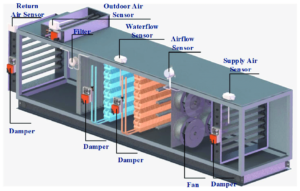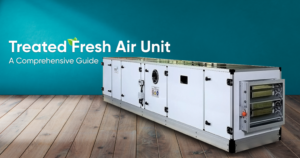AHU and TFA are both acronyms used in HVAC systems for buildings, but they handle air in different ways:
Air Handling Unit (AHU):
An AHU is a workhorse in an HVAC system, conditioning and distributing air throughout a building. Imagine a large metal box that treats incoming outdoor air before sending it on its way. Here’s a breakdown of how an AHU typically functions:
-
- Intake: Outdoor air gets drawn into the AHU.
- Filtration: Filters remove dust, pollen, and other unwanted particles.
- Conditioning: The air is heated or cooled using coils and heating/cooling elements to reach the desired temperature. Additionally, some AHUs can adjust humidity levels.
- Distribution: The conditioned air is then distributed through a network of ducts to various zones or rooms in the building.

Treated Fresh Air (TFA) Unit:
A TFA is a specific type of AHU designed to provide a building with 100% fresh outdoor air. Unlike AHUs, TFAs don’t mix any recirculated return air from the building with the incoming fresh air stream. This makes them ideal for applications requiring a constant supply of clean, fresh air, such as hospitals, clean rooms, and laboratories.

Here’s a table summarizing the key differences between AHUs and TFAs:
| Feature | AHU | TFA |
|---|---|---|
| Function | Conditions and distributes mixed (outdoor and return) air | Provides 100% fresh outdoor air |
| Fresh Air Intake | Mixed with return air | 100% fresh air |
| Applications | General commercial and residential buildings | Hospitals, clean rooms, laboratories |
In essence, AHUs offer more flexibility in handling mixed air streams, while TFAs provide a dedicated stream of conditioned fresh air. The choice between an AHU and a TFA depends on the specific needs of the building and the required level of fresh air ventilation.
Looking to install a commercial HVAC System or Duct work in your Business Area?
Contact Vipul Ac to learn about our HVAC Service
Call +91 8000092000 Today.
